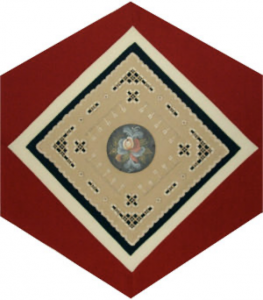Norway

The Block
A classic example of the Norwegian folk art called rosemaling is the focal point of this block. The art was designed, painted and stitched by Irene Fossberg, Grete Grzegorek, Sigrid Simonsen, Ellen Styker and Ragnhild Sveistrup. A form of decorative flower painting that developed in Norway in the late eighteenth century, rosemaling is traditionally worked on wood and is characterized by flowing lines and scrolls, imaginative flowers and subtle colours. It was, and continues to be used to embellish home furnishings (especially tables and chairs, storage trunks, ceilings and walls), and to beautify churches.
The tone-on-tone background, finished with a scalloped edging, features one of Norway’s most recognizable embroidery styles––Hardangersøm. In this piece, Kløster blocks were worked in satin (kløster) stitches, the fabric of the area created was cut away, threads between the blocks were withdrawn, and the resulting cutwork was worked with spider’s web filling stitches. Originally from the Hardanger fjord region, Hardangersøm was once used on church alter cloths. It is now commonly used on household linens and the shirts and aprons of Norway’s national costumes.
Cultural Profile
Norway, a ruggedly beautiful country of mountains, fjords and glaciers, occupies the western portion of the Scandinavian Peninsula. Sometimes called ‘The Land of the Midnight Sun’ because of the almost continuous daylight from May through July, its name means ‘northern way.’ Norway is famous for its seafarers including the Vikings (skilled sailors who built an immense maritime trading network and became the first to cross the Atlantic Ocean), and scientists/explorers Fridtjof Nansen (voyage of the Fram), Roald Amundsen (voyage to the South Pole), and Thor Heyerdahl (the Kon-Tiki Expedition). The country’s rich historic treasures include Viking ships and medieval stavkirker (stave churches that are among the oldest wooden buildings on earth), which were constructed without the use of nails. Norway’s population is primarily Germanic (Nordic, Alpine, and Baltic), with a small Saami minority and an even smaller Finnish group. The official languages are Norwegian, which exists in two form: Bokmål (book language) and Nynorsk (New Norse), and Sami.
The Sami are an ethnic group characterized by their reindeer herding. Their territory extends between Northern Russian, Finland, Sweden and Norway and they are known for their handicrafts, the duodji. These include knives with fir handle and engraved bone or reindeer leather sheath, kuksas, drinking cup made out of birch burl and known to last a lifetime, and the gákti, their traditional clothing. These tunics of reindeer leather or wool feature woven sashes or leather straps in dark blue, red, yellow and green. Very often, patterns of the gákti serve as indicators of the wearers’ place of origin.
Traditional textile arts include tablet weaving to create decorative bands, as well as vertical warp-weighted looms. Those looms, some of the earliest used by mankind, were especially important in Scandinavian countries such as Norway. The construction of the loom allowed the weaver to produce cloth of a large width. This was a perfect tool for Viking women, who would use the loom to make sails for the long ships. Vikings also made tapestries. Fragments from a 1200 year-old tapestry were found in an Oseberg burial ship, an archeological rarity. In more recent times, Åkle tapestries, displaying geometric patterns, have enjoyed a renewed popularity.
The country is also known for its intricately-patterned knitwear, silver jewelry, pewter, and karveskurd (chip-carving). Norway’s distinctive style of wood-carving is recognized by its geometric patterns made with the use of a compass and ruler.
Norwegians steadfastly hold on to many of their cultural traditions, often wearing elaborate folk costumes, or a modernized version called the bunad. These are distinctively embroidered according to region of origin and are worn at weddings and festive events. Traditional folk dancing and singing are popular activities, as is the art of storytelling in which trolls are often featured. One typical Norwegian musical instrument is the hardanger fiddle, an 8 or 9-stringed violin, half of which are sympathetic strings that are not plucked.
Norwegian presence in Canada dates as far back as the tenth century, and in 1962, remnants of a Viking settlement were found at l’Anse aux Meadows. There are records of a few small-scale settlements starting as early as 1814 when sailors, recruited for the Hudson Bay Company, created Norway House in Manitoba. Larger groups subsequently followed, settling in the Gaspé Peninsula and Prairie provinces. They established their own ethnic and religious associations, including the Sons of Norway lodges, and institutes of higher learning such as Camrose Lutheran College and Outlook College. Norwegians have assimilated well into Canadian society, however, a strong cultural identity is still maintained in many homes, where traditions are centred on festivals and foods. Norwegians have made significant contributions to many areas of Canadian life and have brought with them a rich legacy. Today, there are over 452,000 Canadians with Norwegian ancestry. Saskatoon has one of the largest Norwegian communities in the country.
Sponsor: Kirkeringen (Women’s Auxiliary of the Norwegian Church of Montreal), Norske Klubben (The Norwegian Club of Montreal), Grete Grzegorek, Øivind and Ragnhild Sveistrup
